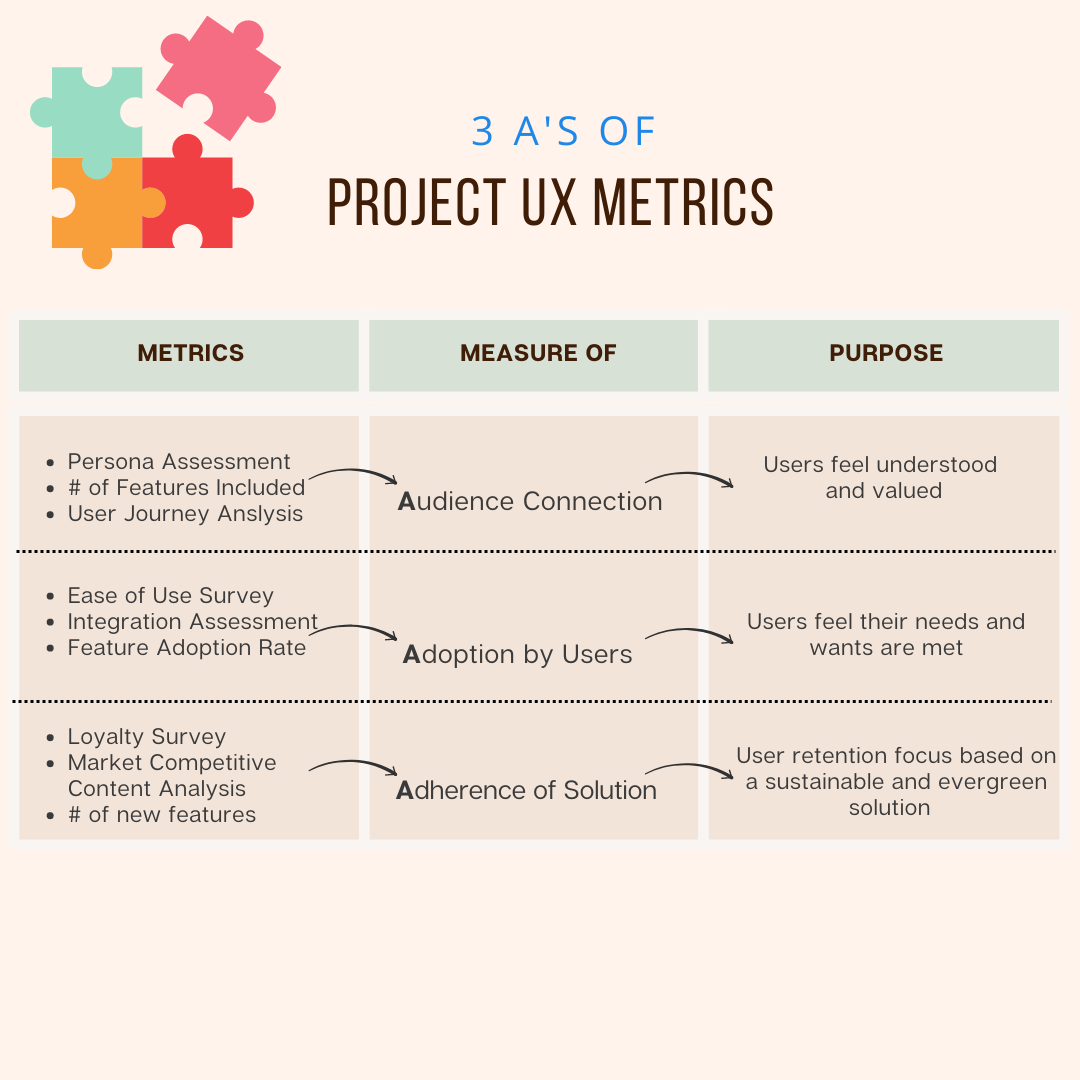3 Essential Customer Experience Metrics
Why are Customer Metrics or KPIs (Key Performance Indicators) so important? Every Product, Project, Solution, and Process has a Customer (either internal or external). To make sure the journey you are creating meets their needs and wants, savvy project and product managers plan and measure for success.
The Goal of Customer Experience Metrics
Understand your Customer.
Define the Customer's needs and wants.
Confirm how well your product or solution meets their wants.
Plan for continuous product improvements to meet current and future Customer's demands.
Increase the mindshare your product has with your Customers.
What are CX Metrics?
Customer Experience Metrics are a way to define, track and measure successful customer interactions using your Product, Project, or Solution.
Projects don't always have a tangible asset or product, however the Customer Experience (CX) can be used based on the User Journey and the Customer's satisfaction with the outcomes for any Solution.
CX Metrics often drive downstream business KPIs like ROI (Return on Investment), and NPM (Net Profit Margin, or the companies revenue to profit ratio). If customers are happy, they buy more. This makes CX measurements important leading indicators for business outcomes.
Why are CX Metrics Important?
Metrics are the missing Puzzle in your Project
Need to know if your Project or Product will be successful? Metrics fill in the missing piece between Users and the components of the Project: Process, People and Technology.
But metrics do more. They challenge the Project to look at success differently. Success is not when things work right, it is when things work for the right people.
Your product or solution is there to meet a need. Metrics measure the success of that product. Confirming the product serves its purpose, delivers on its' promises, and is better than other options. If any of these 3 factors are not satisfied, the solution is likely not sustainable.
From the project viewpoint, the goal of Customer metrics is to confirm you have the right process, people, and product (or technology) to fit your user's needs. This assessment starts and ends with the user. Every aspect of the Project needs to connect with the end user's goals, needs, wants, and ways of working. Exceeding these requirements is often referred to as Customer Delight - the ultimate goal of any Project.
What is the most valuable CX Metric?
The most important CX Metric is the one that gives your team a clear view of Customer Delight. But that metric will vary depending on the kind of Product, Project, or Solution being offered to your Customer.
CX Metrics: Simple and Easy to Use
The best metric is one that is simple, easy to use and understandable to your stakeholders.
Keeping it simple can help you keep the cost of measurement low while gaining the benefits of Customer Centric insights.
Compare and Contrast 2 kinds of CX Metrics
While there are many models to capture Customer Experience (CX) Metrics. Some are a better fit depending on the Customer Solution. Others are useful only after go-live of the Product, while other metrics can be used during the Project to check during design, build and test, and post go-live to test for sustainability of the Solution. In comparing these two models, it is helpful to see where they each have their value.
3 Essential Customer Experience Metrics
The purpose of a Customer Experience Metric is to ensure the Product, Solution or Project meets the of the end user.
Metrics should focus on a specific purpose and goal. This chart focuses on the metric first, since choosing a metric that is relevant and easy to capture is most often the best one to use.
3 A's - Metrics for any Project Solution
If your Product or Project is based on a non-technical Solution, you may want to use this simple metrics model.
Adoption - Do users actually use the solution?
Acceptance - Does the solution meet the user's needs, is it easy to use, or does the user find alternative workarounds?
Adherence - Do the users find the approach ‘sticky’? Do they ask for new features, look for new use cases, and build processes to expand the solution?
As an Alternative, if your Project is focused on a technology or digital solution, Google's HEART may be a great fit. Managers have created this proven metric model at Google to track their key indicators based on the type of Customer or Product being assessed.
5 CX Measures for Digital Work
A much loved and used model, this is a great option for digital projects. The Measures represent aspects of data capture with a specific purpose in mind. The suggested approach is to use one metric per area.
HEART - Measuring Digital Solutions
Google has a process called HEART, an acronym for Happiness, Engagement, Adoption, Retention, and Task success.
HEART works best for digital solutions since the metrics point to various ways organizations, like Google, capture data on their search, selection, and page views. When using HEART, it is important to recognize:
Indicators generally can have multiple metrics.
Choosing the right metric is better than choosing all metrics (cost/benefit ROI reduces with too many to track).
Measuring drives management action.
Management focus can skew outcomes (by creating a false or inflated response from the action targeted Customer).
Data capture assumes a digital product.
How to use Customer Metrics on your Project?
User Survey's
Surveying users can be as simple as asking one question and providing a thumbs up and down for them to click.
Surveys can include multiple questions and a 1-10 ranking, or a series of questions with free-form answers.
End-of-task surveys can also provide insight into a process directly after the user has experienced it. This can be a great way to get actionable feedback from your target audience.
Generally, the simpler, the better. Keeping surveys short and simple will reduce the level of detail but increase the number of respondents.
Click-Through-Rate and Number of Users
For projects that need to communicate to a large audience, using communications as a means to gauge interest is a simple measure. If you send emails or offer QR codes for information sharing, you can also gather information on that execution from the users. This information is passive. The users don't need to respond. This method can provide a simple measure to test regularly.
Time to complete
If a process assessment is your goal. Use a quantitative approach. Test the speed, reliability, or flexibility of the old versus new processes for comparison to test real-world outcomes. Task time, service outcomes, and similar processes can be assessed this way.
Following up with a customer survey can qualitative insight to the quantitive data.
Competitive Market Analysis
While this approach takes more effort, this kind of analysis can create insights into how your Project, Product, or Solution is doing against the competition.
Have an idea you are working on? Google the idea and see if better ideas are out there.
Working on an app? Check app stores to see what other options exist and run through the functionality.
CX Market Comparisons
Use a format to capture data consistently to compare like-for-like whenever possible. It can also be helpful to look as 'disrupters' those companies, products or ideas not directly related to yours. Disrupters can come from anywhere and maybe the benchmark you need to watch.
CX Metrics require assessment and action
Choosing Customer Experience metrics as part of your initial project charter is helpful. This allows for consistency in tracking. You will also be able to budget the staff and time it will take to plan the tracking activities and execute the tracking outcome resolution.
Metrics are only as good and the process set up to act on them. Remember, data, surveys and analysis can be your friend. They can help you understand a process and improve it. But be aware, that if you ask someone their opinion, you must follow up with corrective action. Make sure they know about the fix and follow up again to ensure the fix works.







